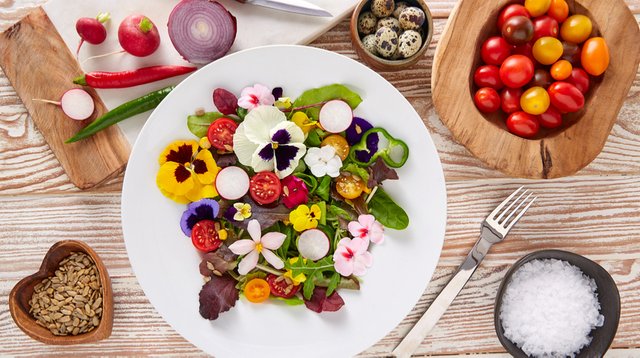Food Journal #9: Edible flowers and how to use them
Today we bring you in search of colorful edible flowers. Do not confuse them with simple toppings and seals. These edible flowers will be the main ingredient of your recipes, as happens for many haute cuisine dishes.

One of the best known and eaten flowers is perhaps the pumpkin flower, but there are different varieties that can be consumed and that will give color, smell and taste to your dishes.
Dill, borage, chervil, carnation, hibiscus, monarda and verbena ... to name a few. Slow Food identifies as many as 40 species, while the Rome University Department of Biology shows us even 50 and we want you to discover their versatility in the kitchen.

How can we use edible flowers?
The choice is wide and each edible flower has smell, sight and taste particular characteristics. From aperitif to dinner, every flower allows to amaze guests with unusual combinations!
- The Alkanet flowers (Anchusa officinalis), with a blue color, can be frozen in ice cubes and used for cocktails.
- Begonia flowers, but only of the tuberhybrida variety, when combined with peppermint, become a refreshing drink, with an acidulous aftertaste like lemon and an anti-inflammatory power.
- The Borage flowers (Borago officinalis) are the perfect ingredient for interesting wine cocktails.
- The Carnation flowers (Dianthus), with a pleasant and delicate scent, are suitable for the preparation of desserts, sauces and to accompany white meat or fish dishes.
- The Nasturtium flowers (Tropaeolum majus) are characterized by intense and vivid colors and have a slightly spicy taste reminiscent of mustard. They can therefore be tasted together with meat.
- Pancakes with eggs, flour and Elderflower (Sambucus nigra) are excellent.
- Dahlia flowers is an excellent ingredient for desserts, it can give a characteristic note of flavor and can have a diuretic and digestive function.

Edible flowers nutritional contents
From a nutritional point of view, edible flowers have beneficial properties for the human organism: very poor in fats and rich in nutrients such as minerals, proteins and vitamins A and C, they have a high quantity of antioxidants.
Collection tips
In flowers collection, we must be very careful not to collect poisonous species and to respect the nature. The flowers collection should be done in the morning, to preserve the scent and texture. Dew and pollen should be eliminated, shaking them gently.
Did you like the post? Please upvote, comment and follow!
This post is really cool. I never thought that there are edible flowers hehe I find this article really interesting. I have resteemed this post as my gratitude to the one who created it. Thanks to the person behind @foodart.
This article came into my feed through the help of @minnowsupporter which has been resteemed under that account. To the one who is working behind that amazing account @minnowsupporter, thank you so much. You have not only helped other stemians but you have brought good post as well to people who love to kill time browsing the web and reading blogs. :)
thank you for sharing for everyone. will be useful. for everyone
I really liked it.
Great post... This post has been resteemed by @minnowsupporter
I was summoned by @foodart. I have done their bidding and now I will vanish...
A portion of the proceeds from your bid was used in support of @youarehope and @tarc.
Abuse Policy
Rules
How to use Sneaky Ninja
How it works
Victim of grumpycat?
Wow! Gorgeous and informative :) Thanks for sharing with the #dailyfoodphotography tag. I'm really enjoying your food journals. Both the writing and the photographs are high quality.